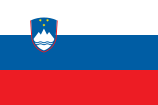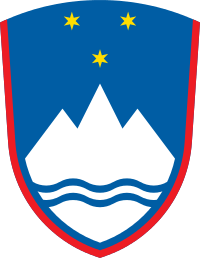Flag of Slovenia
 | |
| Use | National flag and naval ensign |
|---|---|
| Proportion | 1:2 |
| Adopted | 25 June 1991 [1] |
| Design | A horizontal tricolour of white, blue, and red; charged with the Coat of arms at the hoist side |
|
Variant flag of Slovenia | |
| Use | Civil and state ensign |
| Proportion | 2:3 |
| Adopted | 1991 |
| Design | A horizontal tricolour of white, blue, and red, defaced with the Coat of Arms of Slovenia. |
The national flag of Slovenia features three equal horizontal bands of white (top), blue, and red, with the Slovenian coat of arms located in the upper hoist side of the flag centred in the white and blue bands. The coat of arms is a shield with the image of Mount Triglav, Slovenia's highest peak, in white against a blue background at the centre; beneath it are two wavy blue lines representing the Adriatic Sea and local rivers, and above it are three six-pointed golden stars arranged in an inverted triangle which are taken from the coat of arms of the Counts of Celje, the great Slovenian dynastic house of the late 14th and early 15th centuries.[2]
The flag's colours are considered to be Pan-Slavic, but they actually come from the medieval coat of arms of the Duchy of Carniola, consisting of a blue eagle on a white background with a red-and-gold crescent.[3] The existing Slovene tricolor was raised for the first time in history during the Revolution of 1848 by the Slovene Romantic nationalist activist and poet Lovro Toman on 7 April 1848, in Ljubljana, in response to a German flag which was raised on top of Ljubljana Castle.[4]
The civil and state ensign for ships has the same design as the national flag, but a different shape (2:3 instead of 1:2). (Boats up to 24 metres use the national flag as an ensign.[5]) The naval jack uses colours of the coat of arms, a white, blue, and yellow horizontal tricolor.[6]
Historical development
Origins
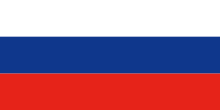
The white-blue-red Slovenian flag was first exposed on April 7, 1848, on a building between Congress Square and Prešeren Square in Ljubljana, by a group of nationally minded students led by the renowned national conservative activist and poet Lovro Toman. Despite opposition from the local Ethnic Germans it was subsequently recognized by the Austrian Government as the official flag of Carniola. This formal recognition, albeit on a regional level, was an exception to the policy of the Austrian Government which tended to persecute national symbols of the non-German nationalities in the Empire. In addition, Austrian authorities saw all tricolours as basically nationalist and potentially revolutionary symbols, so Austrian provinces (as the Empire itself) were only allowed to use bicolours (the only exception being the flag of the Kingdom of Croatia and Slavonia, since it was interpreted to be a combination of the Croatian and Slavonian bicolours). So the official recognition of the Carniolan white-blue-red tricolour instead of the traditional white-blue bicolour was seen as a major achievement by the Slovenes and it quickly became the symbol representing the idea of United Slovenia. In the second half of the 19th century, the Slovenian national tricolour became the only truly all-Slovenian symbol, representing all Slovenes, regardless of the historical region in which they lived.
The tricolour flag continued to be associated with Slovenia during the country's incorporation into Yugoslavia, Although officially the whole kingdom including Slovenia had the same flag, in this case, the blue-white-red. In the interwar period, it was also used by the Slovenes of the Julian March that were annexed to Italy, where it was prohibited and persecuted by the fascist regime.
Slovenian flags during and after WWII
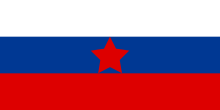
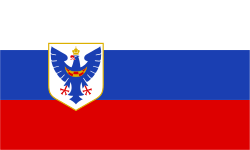

During World War II The Slovene national colours were used both by the Partisan Resistance Movement (usually with a red star in the middle) and by the Slovenian Home Guard, the voluntary anti-Communist militia sponsored and supported by the Nazi German occupation forces.
In 1945 a red star was officially placed on the flag of the Socialist Republic of Slovenia, a constituent of the Socialist Yugoslavia.
Flag of independent Slovenia
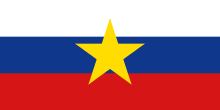
Following Slovenian independence from Yugoslavia, the red star was removed and the new coat of arms, designed by Marko Pogačnik, was added. The flag was officially adopted on June 27, 1991, following a long and controversial dispute about the coat of arms of the new Republic.
New flag proposals
In 2003, a campaign started to partially or completely alter the flag in order to enhance Slovenia's international recognition, and especially to differentiate it from those of Russia and Slovakia. An eleven-striped design won the official contest.[7] Public opinion seems to be strongly against changing the flag at the moment.
 |
.svg.png) |
Government flags
| Flag | Use | Description |
|---|---|---|
 | President of Slovenia | |
 | President of the National Assembly of Slovenia | |
 | Prime Minister of Slovenia | |
 | Minister of Defence of Slovenia | |
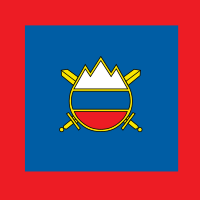 | Chief of the General Staff of Slovenia |
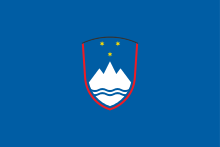 2:3 |  1:2 |
Colours
| Scheme | Blue | Red | Yellow | White |
|---|---|---|---|---|
| CMYK | 100 60 0 10 | 0 100 100 0 | 0 10 100 0 | 0 0 0 0 |
| SCOTDIC Code 777—Int'l Colour Codification System (2034) | N46 N722509 | N23 N074014 | N6 N197512 | N1 N95 |
| *Source: Uradni List RS (5th and 6th page) | ||||
References
- ↑ "A proclamation of The Constitutional Amanademat C to the Constitution of the Republic of Slovenia" (PDF). Official Gazette of the Republic of Slovenia, No. 1/1991. Ljubljana. 25 June 1991. Retrieved 18 October 2013.
- ↑ The Government's site about the flag
- ↑ http://www.dz-rs.si/index.php?id=112
- ↑ Celebration of the Slovene Tricolor (In Slovene: "Praznik slovenske trobojnice"), MMC RTV Slovenia, 7. april 2013
- ↑ Slovenia: Civil and state ensigns and administrative signals
- ↑ Regulations of registration and signalization of vehicles, air- and water-vessels of the Ministry of Defence (in Slovene)
- ↑ Znani Nagrajenci Za Nove Drzavne Simbole
- ↑ "Article 42 Paragraph 3 of the Rules on the Registration and Marking of Vehicles, Aircraft and Vessels of Ministry of Defence". The Official Gazette of the Republic of Slovenia, No. 67/1995, 23. 11. 1995.
- ↑ "Article 1 of the Rules amending Rules on the Registration and Marking of Vehicles, Aircraft and Vessels of the Ministry of Defence". The Official Gazette of the Republic of Slovenia, No. 34/1996, 29. 6. 1996. Retrieved 18 October 2013.
External links
| Wikimedia Commons has media related to Flags of Slovenia. |
